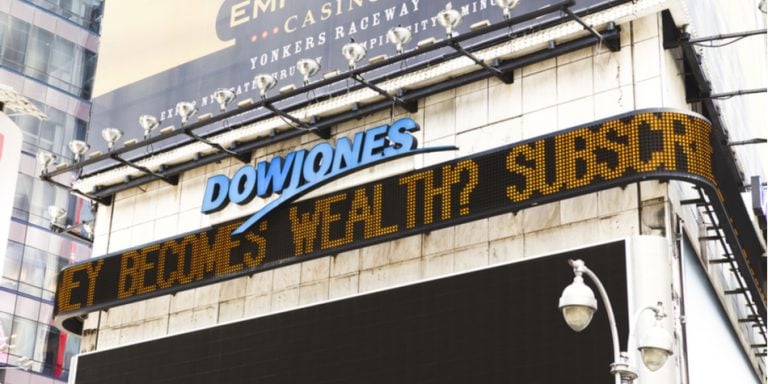On Oct. 18, the Dow Jones Industrial Average hit a new all-time intraday high of 23,145 as of this writing. Investors who aren’t playing the indices can gain exposure to the Dow Jones today through the SPDR Dow Jones Industrial Average ETF (NYSEARCA:DIA). With the index up 16.3% in 2017, though, how much longer can this rally continue?
The Dow Jones is comprised of 30 holdings, which are not weighted by market cap. Instead, they are weighted by stock price. Thus, stocks like General Electric Company (NYSE:GE), Cisco Systems, Inc. (NASDAQ:CSCO) and Pfizer Inc. (NYSE:PFE) make up the lowest weighting, while stocks such as Boeing Co (NYSE:BA), Goldman Sachs Group Inc (NYSE:GS) and 3M Co (NYSE:MMM) make up the largest weighting.
Stocks like Apple Inc. (NASDAQ:AAPL), Walt Disney Co (NYSE:DIS) and Microsoft Corporation
(NASDAQ:MSFT) sit somewhere in the middle.
Dow Jones Earnings
Goldman Sachs, Johnson & Johnson (NYSE:JNJ), UnitedHealth Group Inc (NYSE:UNH) and International Business Machines Corp. (NYSE:IBM) all reported Tuesday. In all, five Dow Jones components have reported and by the end of the week, that number will double to 10.
The following week, another five will report, including three of the five largest (by index weight) with BA, MMM and McDonald’s Corporation (NYSE:MCD). On the one hand (with five stocks in), bulls could argue that the Dow is doing well and that should continue. On the other hand, bears could say the market has run quite a bit and earnings tend to bring volatility into the market. Without a 5% correction in more than a year and even a 3% correction in almost eight months, how long before the music stops?
I’ll be the first to admit, we’ve had our excuses. Two devastating hurricanes, a negative jobs number in September, the brink of war with North Korea. You name it. But the fact is, we haven’t had a correction and earnings are strong. Earnings could cause the 3% to 5% correction, but I wouldn’t expect it to derail the Dow Jones today.
Are We Too Stretched?

Click to Enlarge
Look at the pink boxes now. The first, in December 2016, the Dow rallies then consolidates for the better part of two months. The second came in March 2017, which led to a reasonable pullback of almost 1,000 points. (Note: 1,000 points sounds like a lot, but in this context isn’t even 5%).
Finally, at the bottom we have the MACD, which measures momentum. The Dow Jones is not quite to the levels the MACD sported in its last two big runs. Further, the momentum remains bullish and may not wane.
In a nutshell, the RSI tells us the Dow Jones is overbought, but the MACD suggests more upside could come.
Coming into this week, three of the top five and five of the top 10 holdings in the Dow sported an “overbought condition” according to the RSI. Two are on the brink of that reading as well. With only half technically overbought, there could still be room on the upside for the overall index.
Buy, Sell or Hold the Dow
My concern isn’t necessarily earnings, it’s after. Even if all 30 companies report good results, what catalyst exists to take stocks even higher? Most of these names are rallying in anticipation of good results. So when we get good earnings results, it’s hard to justify pushing them even higher. We see that in the somewhat muted stock reactions.
That’s part of the problem, as we need more buyers to see higher prices. I can’t be a buyer at these levels. No slight correction in eight months? Not a routine one in more than a year? No thanks.
I’m not buying intraday dips here looking to pick up pennies in front of a steamroller. So I am content to hold the few long positions that I have, take profits in some big runners and wait for a normal correction to take place. Nothing catastrophic, just normal.
In that respect, the Dow Jones — and any other major U.S. index — is not a buy right now. It’s not an outright sell, as I wouldn’t be short. But taking some profits never hurt, and staying long overall is what I plan to do until the trend says otherwise.
Bret Kenwell is the manager and author of Future Blue Chips and is on Twitter @BretKenwell. As of this writing, Bret Kenwell was long DIS.
